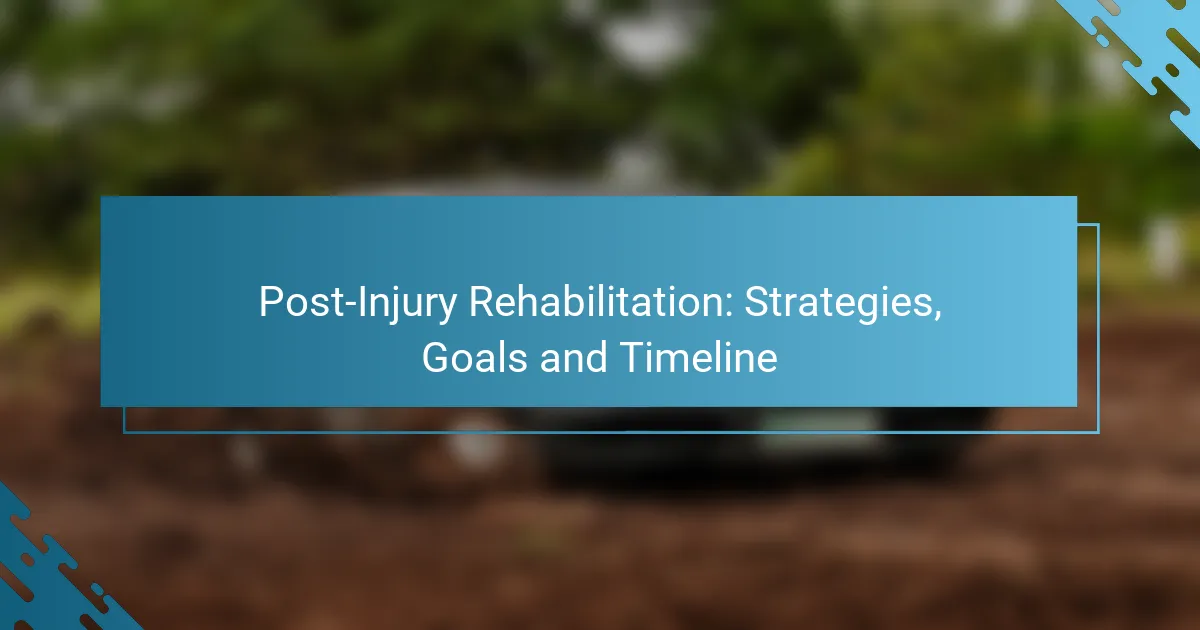Post-injury rehabilitation is crucial for restoring function, alleviating pain, and preventing future injuries. Tailored strategies and structured timelines guide individuals through various phases of recovery, focusing on specific goals such as improving mobility and facilitating a return to daily activities. Understanding the unique needs of each injury is essential for effective rehabilitation.

What Are Effective Post-Injury Rehabilitation Strategies?
Effective post-injury rehabilitation strategies focus on restoring function, reducing pain, and preventing future injuries. These strategies typically involve a combination of therapies tailored to the individual’s specific needs and injury type.
Physical therapy
Physical therapy is a cornerstone of post-injury rehabilitation, emphasizing movement and function restoration. A licensed physical therapist will assess the injury and create a personalized treatment plan that may include exercises, manual therapy, and modalities like heat or ice.
Patients often attend sessions 1-3 times a week, with home exercises to reinforce progress. It’s crucial to communicate openly with the therapist about pain levels and any difficulties encountered during exercises.
Occupational therapy
Occupational therapy focuses on helping individuals regain the skills needed for daily activities. This may include adapting tasks or environments to accommodate physical limitations post-injury.
Therapists often work on fine motor skills, coordination, and cognitive strategies. For example, someone recovering from a hand injury might practice gripping and manipulating objects to improve functionality in daily tasks.
Strength training
Strength training is vital for rebuilding muscle strength and endurance after an injury. It typically involves progressive resistance exercises that target the affected area while ensuring overall body balance.
Starting with light weights or resistance bands, individuals can gradually increase intensity as strength improves. It’s essential to focus on proper form to avoid re-injury and consult with a professional for guidance on appropriate exercises.
Stretching exercises
Stretching exercises are crucial for maintaining flexibility and preventing stiffness in injured areas. Incorporating both static and dynamic stretching can enhance recovery and improve range of motion.
Individuals should aim to stretch major muscle groups 2-3 times a week, holding each stretch for 15-30 seconds. Avoid bouncing during stretches to reduce the risk of further injury.
Hydrotherapy
Hydrotherapy utilizes water’s properties to facilitate rehabilitation, providing buoyancy that reduces stress on joints while allowing for movement. This method can be particularly beneficial for those with severe injuries or pain.
Sessions may include exercises in a pool or specialized equipment like underwater treadmills. Hydrotherapy can enhance circulation, reduce swelling, and promote relaxation, making it a valuable addition to a comprehensive rehabilitation program.

What Are the Goals of Post-Injury Rehabilitation?
The primary goals of post-injury rehabilitation are to alleviate pain, restore function, improve mobility, and facilitate a return to daily activities. Achieving these objectives requires a structured approach tailored to the individual’s specific injury and recovery needs.
Pain management
Pain management is crucial in the rehabilitation process, as it allows individuals to engage in therapeutic activities without discomfort. Techniques may include physical therapy modalities, medications, or alternative therapies like acupuncture. Regular assessment of pain levels can help adjust treatment plans effectively.
Common strategies involve using ice or heat, practicing relaxation techniques, and, when necessary, utilizing over-the-counter or prescribed pain relief medications. It’s essential to communicate openly with healthcare providers about pain experiences to optimize management strategies.
Restoration of function
Restoration of function focuses on regaining the ability to perform daily tasks and activities that were impacted by the injury. This often involves targeted exercises designed to strengthen muscles, improve coordination, and enhance overall physical capabilities. A personalized rehabilitation plan is vital for effective recovery.
Functional assessments can help track progress and adjust exercises accordingly. Incorporating activities that mimic daily tasks can also facilitate quicker adaptation and recovery, ensuring that individuals can return to their normal routines efficiently.
Improved mobility
Improving mobility is a key objective in post-injury rehabilitation, as it directly affects an individual’s independence and quality of life. Rehabilitation may include stretching, strengthening exercises, and balance training to enhance range of motion and stability. Consistency in practice is essential for noticeable improvements.
Using assistive devices, such as walkers or braces, may be necessary during the recovery phase. Gradually increasing activity levels while monitoring mobility can help prevent setbacks and promote confidence in movement.
Return to daily activities
The ultimate goal of rehabilitation is to enable a safe return to daily activities, whether that involves work, sports, or leisure pursuits. This process often requires a gradual reintroduction to these activities, ensuring that individuals do not overexert themselves too soon. Setting realistic timelines and goals can aid in this transition.
Engaging in modified versions of activities initially can help build strength and confidence. Regular follow-ups with healthcare professionals can provide guidance and support, ensuring that the return to daily life is both safe and effective.

What Is the Typical Timeline for Rehabilitation?
The typical timeline for rehabilitation varies based on the type and severity of the injury, but it generally spans several weeks to months. Rehabilitation is divided into phases, each with specific goals and activities aimed at restoring function and promoting recovery.
Initial recovery phase
The initial recovery phase usually lasts from a few days to a couple of weeks, depending on the injury. During this time, the focus is on reducing pain and swelling, often through rest, ice, compression, and elevation (RICE). It’s crucial to avoid activities that could exacerbate the injury.
Patients may also begin gentle range-of-motion exercises as tolerated, which helps maintain mobility without stressing the injured area. Consulting with a healthcare professional is essential to determine the appropriate level of activity during this phase.
Rehabilitation phase
The rehabilitation phase typically spans several weeks to a few months and emphasizes rebuilding strength, flexibility, and functionality. This phase often includes physical therapy sessions that incorporate targeted exercises tailored to the specific injury.
Patients should focus on gradually increasing the intensity and duration of their exercises, while closely monitoring their body’s response. It’s important to communicate with healthcare providers to adjust the rehabilitation plan as needed, ensuring progress without risking re-injury.
Maintenance phase
The maintenance phase can last indefinitely and is crucial for sustaining recovery and preventing future injuries. This phase involves regular physical activity and exercises that promote overall fitness and strength, tailored to the individual’s lifestyle and goals.
Incorporating a balanced routine that includes strength training, cardiovascular exercises, and flexibility work is essential. Setting realistic goals and maintaining consistency will help ensure long-term success in recovery and overall health.

How to Choose a Rehabilitation Program?
Choosing a rehabilitation program involves assessing the specific needs of the injury, the qualifications of the therapist, and the preferences of the patient. A well-suited program can significantly enhance recovery outcomes and ensure a smoother rehabilitation process.
Assessing injury type
The type of injury plays a crucial role in selecting a rehabilitation program. Different injuries, such as fractures, sprains, or post-surgical conditions, require tailored approaches. For instance, a program for a knee injury will differ significantly from one designed for shoulder rehabilitation.
Consider the severity and stage of the injury as well. Acute injuries may need immediate, intensive rehabilitation, while chronic conditions might benefit from a gradual, long-term approach. Always consult with a healthcare professional to determine the best course of action based on the injury type.
Evaluating therapist qualifications
Therapist qualifications are essential when choosing a rehabilitation program. Look for licensed professionals with experience in treating your specific type of injury. Credentials such as a Doctor of Physical Therapy (DPT) or certifications in specialized rehabilitation techniques can indicate a higher level of expertise.
Additionally, consider the therapist’s approach and communication style. A good rapport can enhance motivation and compliance, which are critical for successful rehabilitation. Ask for recommendations or read reviews to gauge the therapist’s effectiveness and patient satisfaction.
Considering patient preferences
Patient preferences should not be overlooked when selecting a rehabilitation program. Factors such as location, session frequency, and treatment methods can significantly impact adherence to the program. For example, some patients may prefer hands-on therapy, while others might favor exercises they can do at home.
Involving the patient in the decision-making process can lead to better outcomes. Discussing options and allowing the patient to express their comfort levels with various treatments can foster a sense of ownership over their recovery journey, ultimately enhancing motivation and success rates.

What Are Common Challenges in Rehabilitation?
Rehabilitation after an injury often presents several challenges that can hinder recovery. Understanding these obstacles is crucial for developing effective strategies to overcome them and achieve rehabilitation goals.
Motivation issues
Maintaining motivation during rehabilitation can be difficult, especially when progress feels slow or setbacks occur. Individuals may experience frustration or doubt about their ability to recover, which can lead to decreased effort in following through with therapy.
To combat motivation issues, setting small, achievable goals can help create a sense of accomplishment. Regularly tracking progress and celebrating milestones, no matter how minor, can also boost morale and encourage continued commitment to the rehabilitation process.
Setbacks and complications
Setbacks such as pain flare-ups, unexpected complications, or emotional challenges can disrupt the rehabilitation timeline. These issues may require adjustments to the rehabilitation plan, which can be discouraging for individuals striving to regain their previous level of function.
It’s important to approach setbacks with a flexible mindset. Communicating openly with healthcare providers about any difficulties can lead to tailored adjustments in the rehabilitation strategy, ensuring that recovery remains on track despite obstacles.
Time commitment
Rehabilitation often requires a significant time investment, which can be a barrier for many individuals. Regular therapy sessions, home exercises, and follow-up appointments can add up, making it challenging to balance rehabilitation with work and personal responsibilities.
To manage time effectively, individuals should prioritize their rehabilitation schedule and integrate exercises into daily routines. Setting aside specific times for therapy and using reminders can help ensure consistency without overwhelming other aspects of life.
